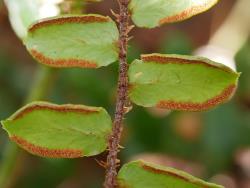Terrestrial or rupestral ferns. Rhizomes short- to long-creeping, scaly. Rhizome scales narrowly ovate, attached at base, concolorous or bicolorous, light to dark brown. Fronds monomorphic (NZ) or rarely dimorphic (not NZ). Stipes and rachises red-brown to dark brown, glossy. Laminae 1-pinnate (NZ) or more divided (not NZ), herbaceous or coriaceous, scaly (NZ) or glabrous (not NZ). Pinnae or pinna segments articulated to rachis or costae, often deciduous. Veins free (NZ) or rarely reticulate (not NZ). Sori extending along the margins; paraphyses present; sori exindusiate or protected by the barely inrolled lamina margin. Spores trilete, lacking chlorophyll; perispores cristate, verrucate, tuberculate or echinate, without an equatorial flange.
A genus of c. 40 species, included in the subfamily Cheilanthoideae along with Cheilanthes (PPG 1 2016).
Pellaea, as currently construed (Tryon 1990; Schuettpelz et al. 2007; Yesilyurt et al. 2015; PPG 1 2016), is not monophyletic, and is in need of revision. Following Field (2020), seven indigenous species of Pellaea are recognised in the Australasian region, including two, P. muelleri (Hook.) A.R.Field and P. reynoldsii (F.Muell.) A.R.Field, that were previously recognised in Paraceterach (Bostock 1998). The remaining five species all belong to sect. Platyloma (Kirkpatrick 2007). However, the limits of some of these species are not well defined and are in need of detailed investigation. Bouma et al. (2010) found that P. calidirupium, P. falcata and P. rotundifolia formed a strongly supported clade, while Kirkpatrick (2007) grouped P. nana (as P. falcata var. nana) with these species in a clade that was most closely related to Pellaea muelleri (as Paraceterach muelleri (Hook.) Copel.) and to some elements of Paragymnopteris K.H.Shing.
Allan (1961) recognised two species, P. falcata and P. rotundifolia, in New Zealand, but only P. rotundifolia is accepted here, with P. falcata considered to be confined to Australia and New Caledonia. Although chloroplast DNA sequence data cannot distinguish P. falcata from P. rotundifolia, the two are distinct in their morphology and cytology (Brownsey et al. 2020). Another species was described as P. calidirupium by Brownsey & Lovis (1990), but is now known to be also present in Australia (Bostock 1998).
Pellaea viridis was recognised as a naturalised species by Webb et al. (1995). However, in a morphological review of Pellaea in southern Africa, Anthony (1984) suggested that the species is better treated in Cheilanthes.
| 1 | Scales on stipes and rachises appressed; pinnae in 2–20 pairs; proximal pinnae widely spaced, on long stalks; sori ± continuous around pinna margins | calidirupium |
| Scales on stipes and rachises spreading; pinnae in 8–40 pairs; proximal pinnae only slightly spaced, on short stalks; sori usually absent from pinna apices | rotundifolia |
In New Zealand, species of Pellaea have long-creeping rhizomes with appressed bicolorous scales, fronds that are 1-pinnate, stipes and rachises that are red-brown and abundantly scaly, pinnae that are articulated to the rachis, sori that are almost continuous around the edges of the pinnae and scarcely protected by slightly inrolled margins, and spores that are echinate (Large & Braggins 1991).
Pellaea is distributed in North and South America, Africa, Asia and Australasia, with the greatest diversity in the Americas and in Africa (Tryon 1990). Four indigenous species in Australia (Bostock 1998) and one in New Caledonia (Brownlie 1969); two species in New Zealand, none endemic.
| Category | Number |
|---|---|
| Indigenous (Non-endemic) | 2 |
| Total | 2 |
The base chromosome number in Pellaea is x = 29 or 30, with diploid, triploid and tetraploid species known in Australasia, and some that are known to be apomictic outside the region (Tindale & Roy 2002).




